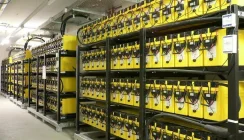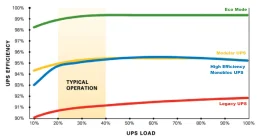How to Choose Between Data Centre UPS Battery Types
Within any power protection system, the type of battery installed can critically impact on the overall performance of the uninterruptible power supply. Aside from different battery brands, sizes, performance specifications and design lives, there are different technologies including valve regulated lead acid (VRLA) and lithium-ion. Whichever is selected, the battery installation must be reliable and cost-effective if it is to provide sufficient power to the UPS system when required and provide the best possible Total Cost of Ownership.
UPS Battery Selection Checklist
Firstly, let’s review the role of a UPS battery set. In an online datacentre UPS, the ‘front end’ is typically an IGBT-based rectifier, connected to the mains power supply, from which it receives a source of AC (alternating current) power. When mains power is not available, an alternative power source could be a generating set. The rectifier assembly converts the input power into two levels of DC; one to charge the battery set and the other to power the UPS inverter. The inverter takes the DC power input and inverts this into an AC waveform to power the load i.e. servers, storage and networking peripherals.
The purpose of the UPS battery is to provide a source of DC (direct current) power to the input of the inverter section, when the AC mains power supply fails or is momentarily interrupted. Without an alternative power source, the inverter would fail within milliseconds and the load drop. Millisecond hold-up is made possible through internal system capacitance but it is not long enough to cover the start-up of a local standby generator or the return of the mains power supply. UPS systems are available for specialist applications with additional capacitor banks; these can provide useful energy storage for transportation or manufacturing line protection.
Within the UPS industry, lead acid batteries have been the dominant battery for many decades. Wet cell lead acid were the most common type before the introduction of valve regulated lead acid (VRLA) maintenance free types. Lithium-ion batteries are widely available in consumer goods, communications and computer products including mobiles, laptops and tablets. Here the battery technology has replaced the more traditional NiCd (Nickel-Cadmium) battery which was banned due to the impact of cadmium on the environment. Lithium-ion battery usage has also grown alongside the renewables industry (solar PV and wind turbine) here it is used to store energy for local consumption or later export to the electricity grid. Only in recent years has lithium-ion been considered as an alternative to lead acid batteries in UPS installations. Here is a comparison checklist between the two UPS battery types: lead acid and lithium-ion:
- Initial Purchase Price: the greater the runtime of the UPS, the larger the battery set. This is one reason why larger datacentres install only a 10-30minute battery and use a standby generator for longer autonomies. Lead acid batteries can be up to 70% lower in cost than than a comparable lithium-ion UPS battery. This is due to lower cost materials, principally lead plates, hydrochloric acid electrolyte and plastic cases. Lithium-ion batteries are more complex, with lower manufacturing volumes for the Ampere-hour (Ah) sizes required for UPS installations and therefore smaller economies of scale. The cost more and require a more complex charging system.
- Backup Power Availability and Recharge Times: a typical rule of thumb for a lead acid battery is to achieve a float recharge to 80% within 24 hours and then to use a trickle charge towards 100%. Lithium batteries recharge far quicker and can achieve 80% within 20-25 minutes or less. This factor makes lithium more suitable for applications, including datacentres, where there are more frequent power outages; several within minutes or hours of each other. For those server rooms and datacentres with standby generators, the UPS battery simply covers the start-up period of the local generating set (1-2 minutes) and so the actual drop in charge percentage of the lead acid battery set is relatively low in comparison. What has to be weighed up is the total cost of ownership of the entire installation including the generating set.
- Floor Space and Weight: lithium-ion UPS batteries have far higher power densities than lead acid batteries. A typical lithium battery set requires up to 50% less floor volume than a lead acid one for the same Ah power and runtime/autonomy. Lithium is also less heavy than lead and this can lead to lower transportation costs and potentially lower installation costs than a lead acid one. With a lead acid battery, the greater weight (up to 70% more) can lead to the need for spreader plates and floor reinforcement if the installation is not on the ground floor or in a basement.
- UPS Battery Testing: both lithium-ion and VRLA type lead acid batteries are maintenance free. Older wet-cell lead acid batteries often required electrolyte top-up during preventative maintenance visits. Whilst modern UPS batteries do not require maintenance, they do require inspection and testing on an annual basis as part of a service visit. Lead acid batteries should be regularly inspected for bulging plastic cases and white residue around their terminals as the installation ages. The internal resistance of a lead acid battery increases with age leading to increased heat during their usage which can buckle the case. Regularly battery monitoring can also build-up a picture as to the operational performance of each battery of its lifetime, indicating how near the battery is to requiring replacement.
- Design and Service Life: there are two main design life types for VRLA batteries. These are 5-year and 10-year designs, with replacement generally required within years 3-4 and 7-8. What is less well known is the design cycles built-into each type of battery which may be around 300-400 complete charge/discharge cycles and at a room ambient of 20-25degC. Lead acid batteries are temperature sensitive and their design lives halves for every one degree rise above 30degC. Lithium-ion batteries are more temperature tolerant and are designed for an almost unlimited number of charge/discharge cycles. With both types material and construction quality also plays a significant factor into how long the battery will last in ‘operational-terms’.
- Safety and Reliability: lead acid batteries are the most used battery worldwide for standby power applications including security alarms, emergency lighting, generator starter motors and uninterruptible power supplies. Over the last 50 years of the UPS industry, millions of lead acid UPS batteries have been installed in applications from small standby and line interactive UPS to large datacentre power systems. Their performance characteristics are well known, the manufacturing quality is high and the predictability as to their design and service life is high. The used type in a UPS is a valve-regulated lead acid (VRLA) type that is maintenance free. Lithium-ion batteries are more complex batteries with a lower field population when it comes to use in UPS and energy storage systems. Li-ion type batteries require a far more complex battery management system and whilst they can operate at high room temperatures (above 30degC than lead acid (20-25degC) they use a component (lithium) which is highly flammable when exposed to air and care should be taken if specified to ensure that there is adequate room temperature monitoring and fire suppression. There are also several lithium battery types available with the lithium element combined with Cobalt, Manganese, Nickel and Iron-phosphate.
- Transportation: whether the batteries are lead acid or lithium-ion, there can be issues during their transportation and installation. Batteries by their nature are energy storage devices and an accidental connection between terminals can lead to a potential short-circuit. Care has to be taken with new batteries and also when removing battery sets during decommission or replacement visit. For lithium-type batteries there are more transportation restrictions (some legislative) covering how they are packaged and transported. Airline movement is one example. VRLA/ lead acid batteries pose less problems and do not generally leak. Their plastic cases are robust and the electrolyte is a gel-based substance and not a liquid. The plastic case may also be flame retardant to add a further level of safety.
- Recycling: the recycling of lead acid batteries is well understood and typically about 95% of the materials can be recycled including the lead plates, plastic cases and electrolyte. Waste hazard collection and recycling centres are available across the UK. Lithium-ion is less easy to recycle. There are far fewer specialist recycling centres in Europe and the batteries use scarce materials including lithium.
The battery-choice related issues can be summarised as:
| Item | Concern | VRLA UPS Battery | Lithium-ion UPS |
|---|---|---|---|
| 1 | Cost | Lower due to widespread usage and scale economies | more expensive to manufacturer and requires a more complex and costly battery charger |
| 2 | Availability | typical float charge to 80% within 24 hours, 300-400 cycles | typical recharge to 80% within 40 minutes, unlimited cycles |
| 3 | Size | larger floor space and weight due to the lead plate component | physically smaller battery cells, higher power density |
| 4 | Maintenance | Visual inspection and handheld battery testing as part of an annual planned preventative maintenance visit | Visual inspection and continuous battery monitoring as part of the battery management system (BMS) |
| 5 | Replacement | 5 year or 10-year design life | 10-15-year design life |
| 6 | Safety | Established technology, little chance of leakage, design life degrades with temperature above 25degC | More concerns over flammability and thermal runaway, more suited to hot aisles as less temperature sensitive |
| 7 | Logistics | VRLA batteries are considered safe for air freighting | Legislative restrictions especially for air freight |
| 8 | Sustainability | More eco-friendly with up to 95% recyclable materials | Fewer recycling centres and harder to recover lithium and separate metals |
The table is not exhaustive and provides a general summary comparison. For more specific information on our UPS batteries please contact our projects team.
Energy Storage, Demand Side Response and Grid Feed-on Tariffs
The UK electricity grid requires significant investment if the country is to discontinue new petrol, diesel and hybrid car sales by 2035. Each new vehicle will by then use either lithium-type batteries or hydrogen-powered fuel cells or some new energy medium that has yet to reach mainstream automotive manufacturers.
The UK grid is also becoming more complex as it incorporates more renewable power sources (e.g. solar, PV, tidal, compressed air and hydro) and large-scale energy storage. There is much anticipation of Ofgem’s next guidelines but these are expected to put a greater focus on how to provide electricity for a dramatic rise in electric vehicle usage and the replacement of gas-fired boilers, central heating and cookers.
There are several energy storage and saving initiatives underway under the National Grid’s Demand Side Response (DSR) program. One way global UPS manufacturers have adapted their uninterruptible power supplies to meet the challenges is to introduce bi-directional rectifiers and offer lithium-ion UPS battery options. Spare battery capacity can be used to generate income for an enterprise or colocation datacentre by supplying this to the grid or by disconnecting the building load from the grid supply for short periods of time i.e. running on battery power.
More info:
https://energystorage.org/uninterruptible-power-systems/
Summary
Lead acid has long been the de facto standard for UPS batteries whether in a computer, server room or datacentre. This is likely to be the case for the next 3-5 years until lithium-ion batteries and their battery management systems becomes less expensive to incorporate into future UPS designs and installations. For now server room and datacentre UPS installations will continue in the main to use VRLA-type batteries, with lithium-ion being adopted if there is more of an energy storage and/or demand side response type application.


























